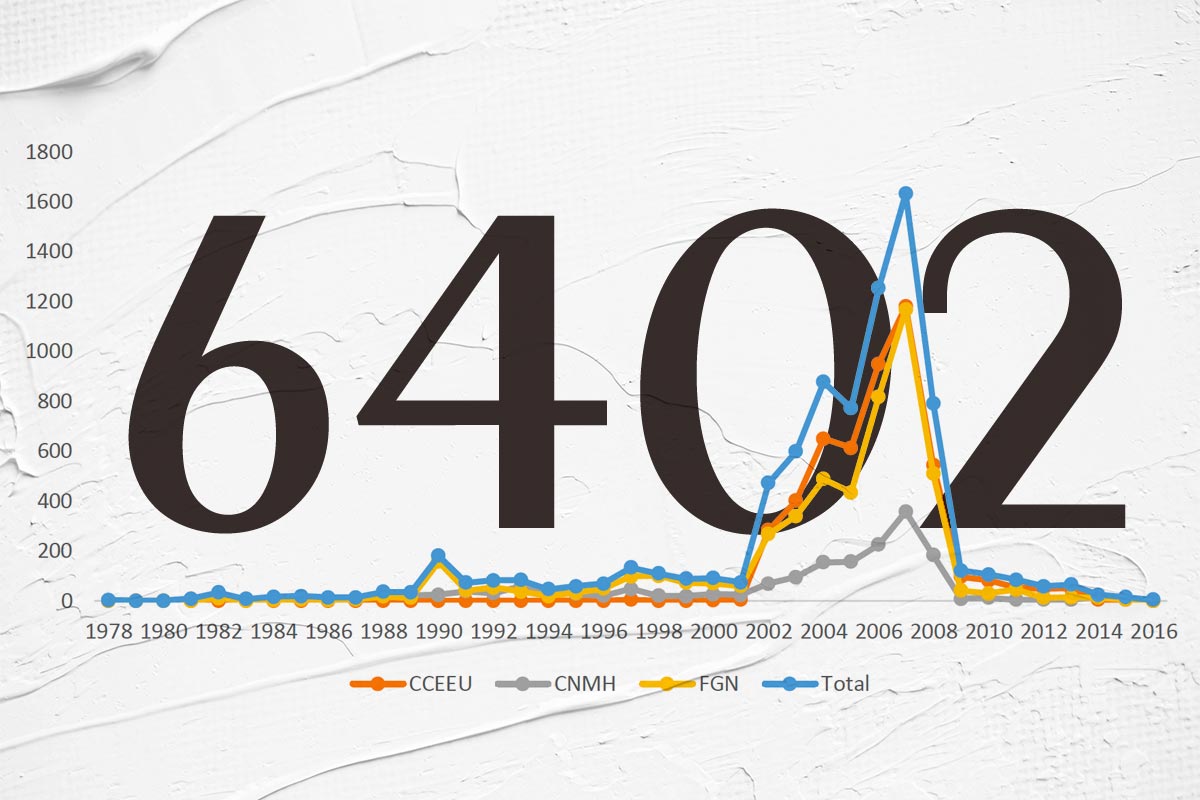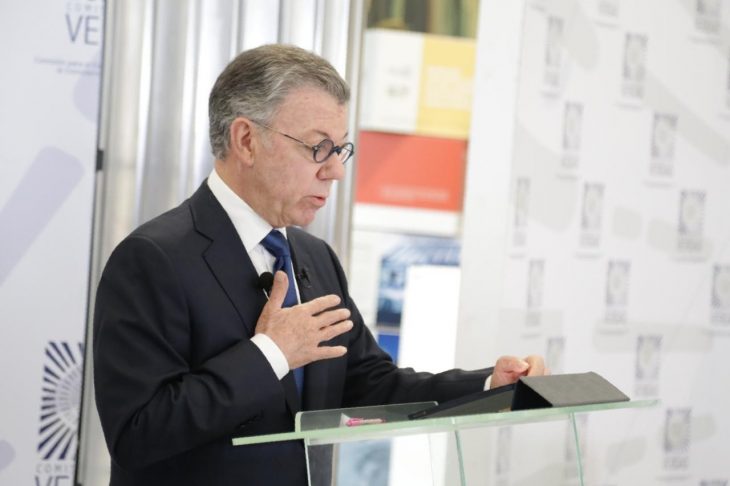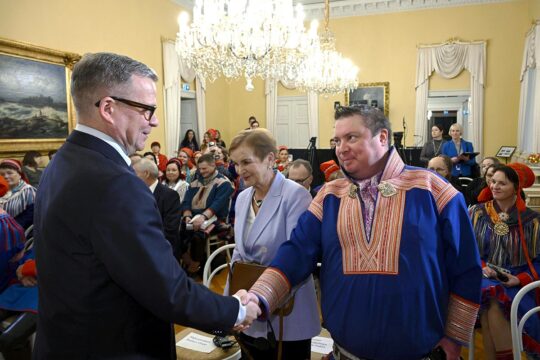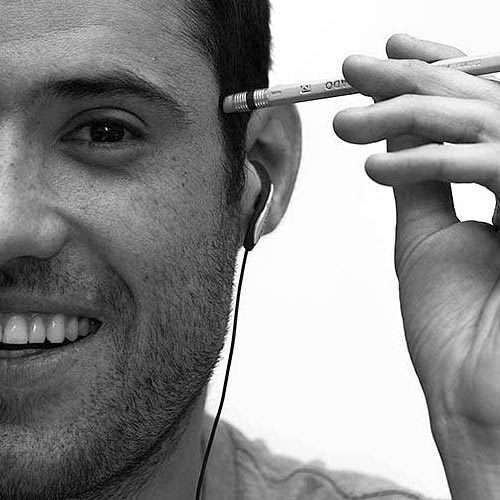“I am left with the remorse and deep regret that during my period as minister many, many mothers (…) lost their children. This should have never happened,” Juan Manuel Santos gravely stated. This was the end of an almost two-hour speech in which Colombia’s president between 2010 and 2018 detailed how he became aware that civilians were being murdered by military officials and unlawfully passed off as rebels killed in combat, and how he took steps to put an end to these atrocities. “I acknowledge this and I ask forgiveness from the depths of my soul to all the mothers and the families who were victims of this horror. May this never, ever happen again,” were the final words of Santos’s remarks.
As he left the lectern and sat down, a visibly shaken Truth and Reconciliation Commission (TRC) chairman struggled to translate his emotions into words. “It is very rare for a president of the Republic to ask for forgiveness, to personally acknowledge responsibility, to feel moral responsibility and the pain of victims”, Jesuit priest Francisco de Roux said.
A President before the TRC
Santos, who was Defence Minister before his 2010 election, voluntarily went to the TRC to address his role during a tragedy that has appalled Colombians for over a decade and that became euphemistically known as ‘false positives’. Behind that misnomer lays a macabre practice: at least 6.402 civilians were murdered by state agents between 2002 and 2008, according to recent preliminary findings by the Special Jurisdiction for Peace (JEP), the judicial arm of Colombia’s transitional justice, which have sparked outrage in the country.
Even though it was Santos who signed the landmark 2016 peace deal with the Revolutionary Armed Forces of Colombia (FARC) and has been a staunch defender of the transitional justice system stemming from it, it is still much rarer for former presidents and other civilian political leaders to admit their responsibility than for soldiers and former combatants.
“I have come to tell you my truth”
Santos’s speech, poignant at times and self-centred at others, illustrates his own complexities. As he said at the outset, “I have come to tell you my truth.” He also settled some political scores in the process, underscoring how different his views on the armed conflict were with then president Álvaro Uribe, his erstwhile boss and political godfather turned into his nemesis. He characterised Juan Carlos Pinzón, his now estranged former private secretary and a vice-minister at the time, as having been in favour of denying all wrongdoing within the Colombian Army. While that may be true, it doesn’t explain why Santos would later name him chief of staff, ambassador in Washington and, of all things, Defence Minister for four years – right during the peace negotiations.
Spotlight on corrective steps
The brunt of Santos’s appearance before the TRC was devoted to explaining, in painstaking detail, the corrective measures taken by him, his vice-minister Sergio Jaramillo and his team of advisors. In his words, “an account of how we investigated, denounced and put an end to false positives.”
A key aspect of the Colombian TRC’s mandate is to identify moral actions and positive transformations carried out by victims, communities and institutions during the conflict. This task was included in the peace deal in a bid to ensure that the commission would not only investigate wrenching episodes, but also document inspiring and empowering stories. Unfortunately, the TRC has so far made little headway on this, according to a recent congressional report.
Over two hours, Santos described the different changes that took place after he entered Uribe’s government. First, inspectors were named in every single of the Army’s divisions to facilitate internal investigations and the Defence Ministry’s human rights office was elevated in rank. The first human rights and international humanitarian law policy for the military was drafted, bringing in operational legal advisors to counsel commanders during the planning of military operations. The Ministry also drafted Colombia’s first ever operational law handbook detailing rules of engagement and overhauled incentives, scrapping body counts and favouring demobilisations and arrests over kills. The length of training and rest periods was reformed after being deemed insufficient. And dozens of military officers were ousted, including three generals and four colonels.

– reflect similar extrajudicial executions patterns over time. © JEP / JusticeInfo.net
Many of these changes were instituted with help from outside, most notably from the UN Human Rights Office and the International Committee of the Red Cross (ICRC), whose officials were allowed to tour military units to contrast information. This array of corrective measures - which in hindsight might have legally saved both Uribe and Santos – may explain why, as Colombia’s special peace tribunal highlighted in its prioritisation plan, there was a significant 92% drop in cases between 2007 and 2009. “I genuinely believe that the fundamental goal of ending false positives was achieved,” Santos said, at one point displaying the JEP’s graph, while admitting that “despite having done everything humanely and legally possible, we weren’t able to end them at once.”
Unsung heroes
A particularly poignant part of Santos’s account focused on highlighting the roles played by persons who, far from public scrutiny, made great and often overlooked efforts to bring these crimes to justice.
One of them was General Carlos Arturo Suárez, who was tapped to lead a fact-finding mission that investigated several emblematic cases and whose findings – known as the “Suárez Report” - laid the ground for reforms. One episode he detailed was the murder of a dozen youngsters from the city of Soacha, who were duped with fake job offers by state agents and murdered 635 kilometres away from their homes, some of them deliberately targeted because they had mental health illnesses or problematic drug use.
Another anonymous hero was Luz Marina Gil, who in September 2006 became the first civilian – and woman - to lead the military justice system. The daughter of a general, this former Defence Ministry attorney transfered hundreds of investigations into human rights violations to the ordinary justice, following a Constitutional Court ruling that had been rarely observed before.She was the first to enforce an order bringing in civilian judicial police investigators to process combat zones as crime scenes, before anyone else came along.
Finally, there is Carlos Franco, a former Popular Liberation Army (EPL) rebel who signed a peace deal in 1991 and who headed the human rights office in the Vice-Presidency. He managed to establish that nine of the Soacha youngsters reported as missing were presented as combat kills days later in northeast Colombia. His inquiries paved the way for the uncovering of one of the most disturbing patterns of the scandal.
What Santos left out
Given Santos’s focus on numbering scores of directives and decisions, many Colombians saw his appearance as somewhat staged and detached. For several observers, his reconstruction of corrective measures is very valuable, but fails to address the policies that rendered them necessary in the first place.
“We’re still finding missing pieces in this puzzle”, says María Emma Wills, a former National Centre for Historic Memory researcher. “Any public policy has three key moments: when it is conceived, when it becomes ingrained within an institution and when it’s monitored. Beyond the documents, who took part in discussions about such a discredited policy like body counts and how did they unfold? What were the arguments? Did anyone follow-up on its results?”
Santos did mention some likely causes, including perverse incentives such as body counts and prizes, a sustained pressure to increase combat kills (which he dubbed “the original sin”) and president Uribe’s belief that the FARC had to be obliterated, instead of driven to a negotiation table. But “he only addressed the causes superficially. It’s a fact that there was an exponential increase in these executions, which means something had to trigger it. Yet that something is still not clear,” says Silvia Serrano, an international human rights law expert who teaches at Georgetown University.
Santos’s description of false positives as something “inconceivable”, is problematic in Serrano’s view. In particular, she cites a 2018 Inter-American Court of Human Rights ruling against Colombia, which determined that in five extrajudicial executions dating back to the 1990s, public institutions had warned about evidence of feigned combats. “Saying that it’s so hard to imagine this could happen that it wasn’t believable, is not plausible when you’re an experienced public servant,” says Serrano, who worked for 14 years as an attorney at the Inter-American Commission on Human Rights. “The contextual information was there: when Santos realised, upon arriving, that these incentives and pressure to increase combat kills existed, he should have known that they could lead to these consequences.”
“Who gave the order?”
Santos’s speech underscored how difficult it will be to meet many victims’ expectations. A few have reacted negatively to his words. Luz Marina Bernal, one of the mothers of Soacha whose 26-year-old son Fair Leonardo Porras was murdered in January 2008, described it as “a cold, calculating and imposed request for forgiveness” only meant to “cleanse his image”.
“I’d like him to explain how it can be that a widespread criminal practice that has been going on since the 1980s, denounced in Colombia and abroad, backed by court rulings, could in 2006 only be - in his words - ‘rumours’ supported by ‘weak evidence’,” she said. Her organisation, the Mothers of False Positives, has been using the rallying cry ‘Who gave the order?’ and painting murals throughout the country, elevating the pressure to identify those most responsible for their sons’ murders. In her view, Santos and Uribe should both be tried.
Although Porras’s murder came to light in August 2008, it was a different case which Santos cited as the moment when he said he understood the full scope of what was happening. Some weeks before, Santos recounted, the UN had facilitated a meeting between the then minister, his top military commander General Freddy Padilla and a soldier, who told them the tragic story of how his 67-year-old father Aicardo Ortiz had been murdered and presented as a dead rebel. “For the first time, the reality of false positives stared us in the face,” he said, underscoring how it took the case of a victim from within the Army to drive the point home.
To María Emma Wills, Santos’s testimony underscores how Colombian institutions often ignore or discredit those voices who warn about major problems, a reality compounded by the fact that the country doesn’t encourage or protect whistle-blowers. In her view, this is one of the key takeaways to ensure non-recurrence of violence in the future. “Who you believe has to do with with those constructed loyalties and instilled mentalities: we need to understand where they come from and how they operate”, she argues.
Will other presidents come forward?
Santos’s appearance before the TRC inevitably kicked off another question: will his predecessor - and the peace deal’s most formidable critic - Uribe do so too?
In an interview last week, Uribe ruled out speaking to the truth commission, defended his corrective measures and emphasised that he had already asked the mothers of Soacha for forgiveness. Anyhow, Father de Roux reiterated the TRC’s openness to listen to him.
Ernesto Samper, one other former president had already gone before the TRC, but the value of his truth-telling is far from clear. On two occasions, Samper tried to appear forthcoming and defended truth as a necessary contribution to national reconciliation. But he shied away from detailing the controversial aspects of his presidency between 1994 and 1998, including the judicially proven links between the Cali drug cartel and his electoral campaign, or what led to the strong uptick in Colombia’s number of victims, which more than tripled during his term to over 300,000 per year.
A ticking clock
In a sign of how urgent these missing truths are, one of the better-known victims of false positives died of Covid-19 one day after Santos’s speech. For over a decade, pedestrians in downtown Bogota became used to the sight of an old Dodge truck plastered with photos and press cutouts. It was 73-year-old greengrocer Raúl Carvajal’s way of calling attention to the plight of his son, corporal Raúl Antonio Carvajal, who he believed was murdered by fellow soldiers in 2006 after refusing to participate in extrajudicial executions.
Officially considered to have died in the middle of a combat, his father ‘Don Raúl’ – as Bogotanos affectionately called him - sought information that would help him prove what really happened. The kind of truths that the TRC is hoping to shed light on, although its clock is also quickly winding down towards the end of its three-year mandate in November.







